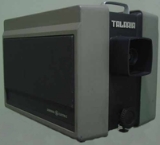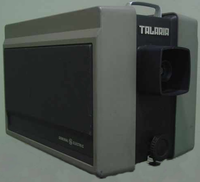
Talaria projector
Encyclopedia
Talaria was the brand name of a large-venue video projector
from General Electric
.
 Light from a Xenon arc lamp
Light from a Xenon arc lamp
was modulated by a light valve
consisting of a rotating glass disc that was continuously re-coated with a viscous oil. An electron beam similar to the one in a cathode ray tube
traced a raster
on the surface of the coated glass, deforming the surface of the oil. Where the oil was undisturbed, the light would be reflected into a light trap. The raster traced into the oil formed a diffraction grating
.
The basic unit was monochrome (PJ7000 line). Color display is accomplished in one of two ways:
The single lens color projector (PJ5000 line) use dichroic filters to separate the white light of the xenon bulb in two channels, Green and Magenta.
RGB color separation and processing is obtained using vertical wobbulation of the electron beam on the oil film to modulate the green channel and sawtooth modulation is added to the horizontal sweep to separate and modulate Red and Blue channels. The optical system used in the Talaria line is a Schlieren
optic like an Eidophor
, but the color extraction is much more complex.
Two units (MLV) or three units (3LV) are stacked one atop the other, each one devoted to a single color (3LV).
In early models (PJ5000), the light source was a 650 watt xenon bulb (sealed beam) similar to the units in modern 35mm film projectors, and produced 250 lumens at a 75:1 contrast ratio. The later 3LV model produced as much as 3500 lumens at a 250:1 contrast ratio.
Video projector
A video projector is an image projector that receives a video signal and projects the corresponding image on a projection screen using a lens system. All video projectors use a very bright light to project the image, and most modern ones can correct any curves, blurriness, and other...
from General Electric
General Electric
General Electric Company , or GE, is an American multinational conglomerate corporation incorporated in Schenectady, New York and headquartered in Fairfield, Connecticut, United States...
.

Xenon arc lamp
A xenon arc lamp is a specialized type of gas discharge lamp, an electric light that produces light by passing electricity through ionized xenon gas at high pressure to produce a bright white light that closely mimics natural sunlight...
was modulated by a light valve
Light valve
A light valve is a device for varying the quantity of light, from a source, which reaches a target. Examples of targets are computer screen surfaces, or a wall screen in the case of a light projector....
consisting of a rotating glass disc that was continuously re-coated with a viscous oil. An electron beam similar to the one in a cathode ray tube
Cathode ray tube
The cathode ray tube is a vacuum tube containing an electron gun and a fluorescent screen used to view images. It has a means to accelerate and deflect the electron beam onto the fluorescent screen to create the images. The image may represent electrical waveforms , pictures , radar targets and...
traced a raster
Raster graphics
In computer graphics, a raster graphics image, or bitmap, is a data structure representing a generally rectangular grid of pixels, or points of color, viewable via a monitor, paper, or other display medium...
on the surface of the coated glass, deforming the surface of the oil. Where the oil was undisturbed, the light would be reflected into a light trap. The raster traced into the oil formed a diffraction grating
Diffraction grating
In optics, a diffraction grating is an optical component with a periodic structure, which splits and diffracts light into several beams travelling in different directions. The directions of these beams depend on the spacing of the grating and the wavelength of the light so that the grating acts as...
.
The basic unit was monochrome (PJ7000 line). Color display is accomplished in one of two ways:
The single lens color projector (PJ5000 line) use dichroic filters to separate the white light of the xenon bulb in two channels, Green and Magenta.
RGB color separation and processing is obtained using vertical wobbulation of the electron beam on the oil film to modulate the green channel and sawtooth modulation is added to the horizontal sweep to separate and modulate Red and Blue channels. The optical system used in the Talaria line is a Schlieren
Schlieren
Schlieren are optical inhomogeneities in transparent material not visible to the human eye. Schlieren physics developed out of the need to produce high-quality lenses devoid of these inhomogeneities. These inhomogeneities are localized differences in optical path length that cause light deviation...
optic like an Eidophor
Eidophor
An Eidophor was a television projector used to create theater-sized images. The name Eidophor is derived from the Greek word-roots ‘eido’ and ‘phor’ meaning 'image' and 'bearer'...
, but the color extraction is much more complex.
Two units (MLV) or three units (3LV) are stacked one atop the other, each one devoted to a single color (3LV).
In early models (PJ5000), the light source was a 650 watt xenon bulb (sealed beam) similar to the units in modern 35mm film projectors, and produced 250 lumens at a 75:1 contrast ratio. The later 3LV model produced as much as 3500 lumens at a 250:1 contrast ratio.

